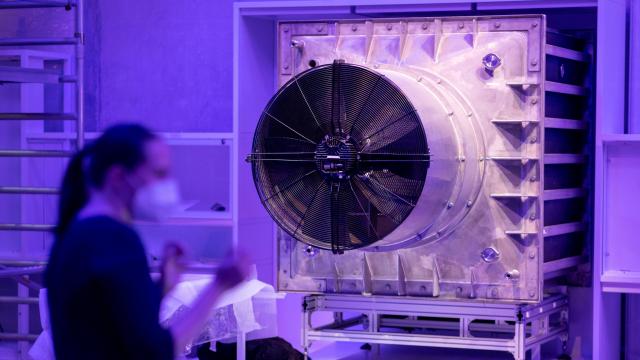Scientists agree that we’re going to need to build machines to suck carbon from the sky to stave off the worst impacts of climate change — but there are a lot of challenges for this new industry in the coming decades, including figuring out how to make the technology more effective. A discovery from a team of researchers at Lehigh University, published in Science Advances on Wednesday, could make this process three times more productive.
The process of sucking carbon dioxide from the sky — known as direct air capture, or DAC — may sound like science fiction, but it’s actually a pretty simple proposition. Machines capture air from the atmosphere, which is then run through filters and sorbents to separate out the CO2; those filters are heated to release the CO2, and that concentrated CO2 is then either stored underground or can be used in products.
Capturing and separating out CO2 is a lot easier when the pollutant is concentrated at a particular source, as is the case with carbon capture and sequestration, which involves installing filters at factories, power plants, and other infrastructure that spews out CO2. Filtering out CO2 from everyday, regular air, on the other hand, where the CO2 is more diluted, requires a lot of energy and a lot of money.
That’s a big obstacle for an industry that scientists say will be necessary to stave off the worst impacts of global warming and is only just beginning to get off the ground. There are fewer than two dozen direct air capture plants currently operating in the world, pulling just thousands of tons of CO2 each year at a steep cost. Despite enormous financial and cultural investment in the technology, there are real questions about how scalable and efficient DAC will ever be.
This new research could help change some of that productivity measure for existing and new plants, just by switching up what’s inside the machines. Most direct air capture processes currently use amine-based materials — made from ammonia — in their filtering processes. What the researchers did was add copper to an amine-based sorbent, a pairing that is pretty well-known in chemistry.
“Amine means they have nitrogen atoms,” said Arup Sengupta, a professor of engineering at Lehigh University and a co-author of the paper. “Nitrogen and copper, they love each other.” Adding copper into the mix meant that the new hybrid sorbent can filter out CO2 three times as well as existing sorbents on the market, a potentially game-changing performance improvement that could significantly lower costs and improve the efficiency of DAC plants.
“An ultra-low concentration [of CO2] is no longer an obstacle to this process,” Sengupta said.
The addition of copper gave this sorbent another advantage: the possibility of storing CO2 in the ocean in addition to underground. When the CO2-saturated copper-amine material was brought in contact to seawater in the lab, it converted the captured CO2 into what is essentially baking soda. This harmless alkaline material could theoretically be stored in the ocean, opening up a possible new storage mechanism for captured CO2. The world’s existing carbon capture plants, like the Climeworks plant in Iceland, are right now restricted to being located in places where there’s significant underground storage available; opening up the potential for DAC plants to be built anywhere close to a coast significantly expands the possibilities for the technology.
Obviously, there are a lot of questions raised by some of this research. The world’s oceans are under enough stress as it is, and there’s a big difference between testing out small samples of the hybrid material in seawater versus suddenly dumping tons of baking soda into the ocean each year. And even if the resin created by Sengupta and his team significantly improves the productivity of the world’s DAC systems, there are still a lot of big hurdles facing the technology — and it doesn’t get rid of the issue of oil and gas propping up DAC as the end-all solution in lieu of actually cutting emissions now and weaning off their products.
Still, it’s exciting to see potential new leaps and bounds for DAC technology and to see how research like this could potentially change conditions on the ground. Sengupta said his team will be looking for support in testing out their new material on a larger scale.
“Everything works in the lab,” Sengupta laughed. “When you take it out, it’s a different story.”
